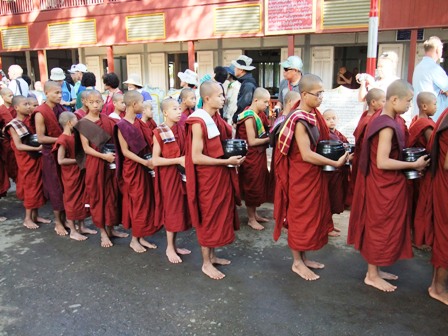
Click the photo above to see an album of photos. To return to our website close the window.
Read previous Road to Mandalay or next Bagan
11 January 2010
The crowd of tourists, Ray and I among them, has arrived at 10:15 AM and are eagerly awaiting the monks file in to the Maha Ganayon Kyaung Monastery in Amarapura for their once daily meal. We have toured the kitchens where vast cauldrons of food and rice are heating over wood fires. We pass by large sleeping buildings where up to 1000 young monks stay, then walk around to the dining room where a food distribution table has been set up in a courtyard at the entrance. A young junior novice, dressed in white robes, is waiting to distribute two oranges to each of the monks. He is amusing himself making a tower of oranges while he waits for the monks to come. A group of Asian tourists come into the courtyard carrying plastic bags full of small packages. These are donations of items for personal care. You can buy already assembled packages in shops in Mandalay and bring them with you to a monastery. After the donations are received and blessings given the monks briskly march in, several hundred of them, single file, barefoot and carrying their begging bowl. They receive their oranges, fill their bowls from big vats of rice and a meat stew and file in to take their places at long wooden tables. It is almost like watching animals in the zoo and I feel rather ashamed but I take photos along with every one else. At least I don't stick my camera in the face of a monk as they file past.
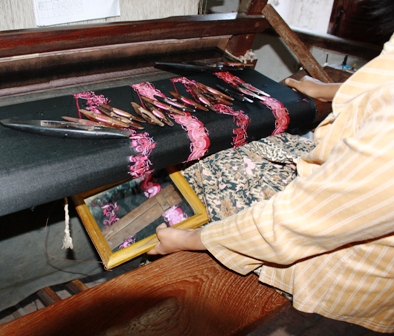
Inwa, formerly known as Ava, served as the capital of the Burmese kingdom for 400 years, longer than any other city. It is an island separated from the mainland by two canals in the Ayeyarwady River. Our driver left us at a ferry jetty where he waited for our return. We shared the flat-bottomed boat with several other tourists and locals and motored across the canal to Inwa. Horse carts and drivers were waiting for the tourists and we got in one to be taken to some of the remaining pagodas on the island. There is no thriving city here, just fertile fields of rice, soybeans, sunflowers and rice. It was very peaceful. We passed by a few small huts where the driver greeted his young son. The remains of the old city gates were on our route and we stopped to explore a few small red brick temples.
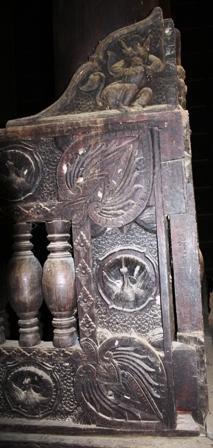
A 27 M high masonry watchtower, Nanmyin is the only remaining feature of a palace built by one of the kings is. After the upper portion was shattered by an earthquake in 1838, it developed a decided list and ever after became known as "the leaning tower of Inwa". It had been reinforced sufficiently to allow us to climb steps to a platform where we had a good view of the fields and other temples in the area.
It was lunchtime by the end of our tour. We enjoyed a peaceful meal in a very nice garden restaurant conveniently located near the ferry jetty.
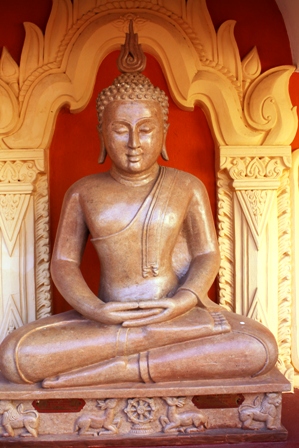
Every trip to Sagaing includes a drive, or a very long walk, to the top of the hill crowned by a golden temple. We drove up to admire the view and then returned to Amarapura.
U Bein's Bridge, the most photographed bridge in Myanmar, stretches 1240 M from Amarapura across the shallow Taugthaman Lake to a village on the other side. The teak footbridge was built 200 years ago and is still in use. We elected to walk across and take a boat back to get a different perspective from the water. We were there in late afternoon when the daily commute of locals to their village on the other side begins. Beggars, some in pitiful condition, sat on the bridge hoping for donations from the many tourists. Fishermen worked the waters below us and one man herded his flock of ducks to their overnight location. Our boatman was waiting for us on the far side, having rowed across. He rowed us back standing, using two long oars to propel the long flat boat. We had an option to wait for sunset for our return trip but we were content to enjoy the view during the ½ hour ride before it got dark.
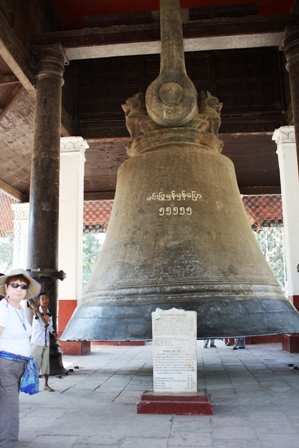
We spent a pleasant morning touring the site, escaping from the ever-present souvenir vendors and having a quiet lunch at a simple village restaurant.
Lonely Planet highly recommends attending a performance by the Moustache Brothers Troupe. We hired a "blue taxi", a converted pickup truck with benches in the back, to take us to the home of the brothers. They are famous for their political jokes which have more than once landed them in jail. They are currently under house arrest and are allowed to perform in their home for tourists, not local people. Nine of attended that night, sitting in plastic chairs facing a small stage. Lu Maw, who speaks the best English, opened the performance with a review of their history including DVD clips of mentions and support they have received from Western comedians and actors. He also told us that profits from the show go towards supporting political prisoners. Despite official bans for support of Aung San Suu Kyi, the opposition leader who has been under house arrest off and on, mostly since 1989, the brothers prominently display posters of her and themselves with her. The rest of the show consisted of corny jokes, which managed to be funny and traditional dances performed by brothers Par Par Lay and Lu Saw, Lu Maw's wife, two sisters and a sister-in-law, a truly family enterprise. We left at the end of the performance but others stayed to talk and ask questions of the brothers. It was an interesting and informative evening.